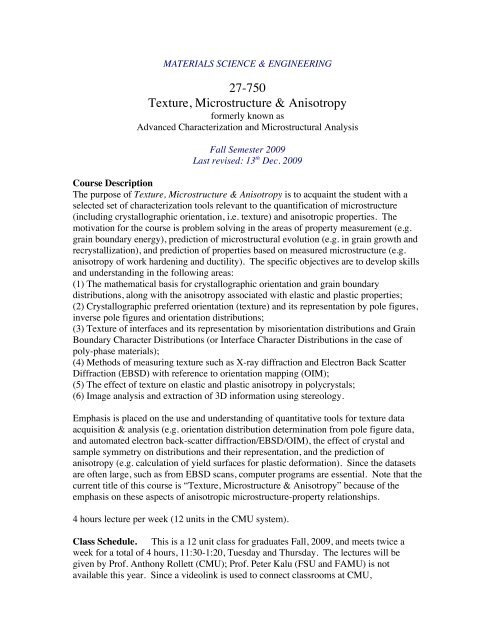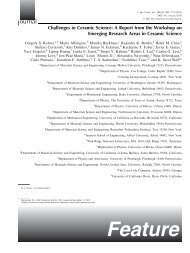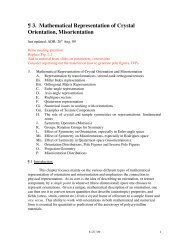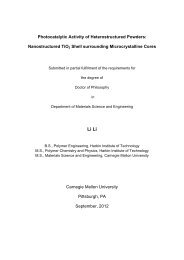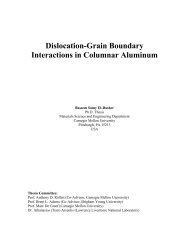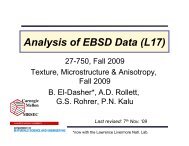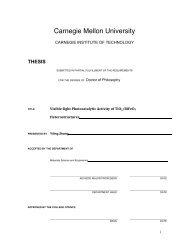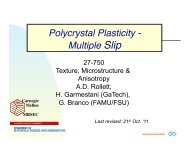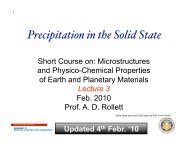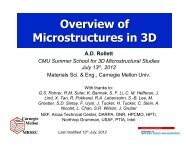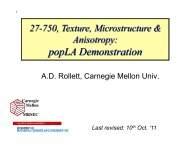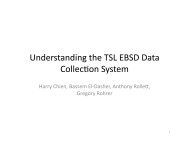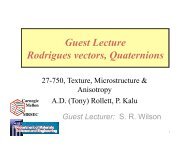27-750 Texture, Microstructure & Anisotropy - Materials Science and ...
27-750 Texture, Microstructure & Anisotropy - Materials Science and ...
27-750 Texture, Microstructure & Anisotropy - Materials Science and ...
You also want an ePaper? Increase the reach of your titles
YUMPU automatically turns print PDFs into web optimized ePapers that Google loves.
MATERIALS SCIENCE & ENGINEERING<br />
<strong>27</strong>-<strong>750</strong><br />
<strong>Texture</strong>, <strong>Microstructure</strong> & <strong>Anisotropy</strong><br />
formerly known as<br />
Advanced Characterization <strong>and</strong> Microstructural Analysis<br />
Fall Semester 2009<br />
Last revised: 13 th Dec. 2009<br />
Course Description<br />
The purpose of <strong>Texture</strong>, <strong>Microstructure</strong> & <strong>Anisotropy</strong> is to acquaint the student with a<br />
selected set of characterization tools relevant to the quantification of microstructure<br />
(including crystallographic orientation, i.e. texture) <strong>and</strong> anisotropic properties. The<br />
motivation for the course is problem solving in the areas of property measurement (e.g.<br />
grain boundary energy), prediction of microstructural evolution (e.g. in grain growth <strong>and</strong><br />
recrystallization), <strong>and</strong> prediction of properties based on measured microstructure (e.g.<br />
anisotropy of work hardening <strong>and</strong> ductility). The specific objectives are to develop skills<br />
<strong>and</strong> underst<strong>and</strong>ing in the following areas:<br />
(1) The mathematical basis for crystallographic orientation <strong>and</strong> grain boundary<br />
distributions, along with the anisotropy associated with elastic <strong>and</strong> plastic properties;<br />
(2) Crystallographic preferred orientation (texture) <strong>and</strong> its representation by pole figures,<br />
inverse pole figures <strong>and</strong> orientation distributions;<br />
(3) <strong>Texture</strong> of interfaces <strong>and</strong> its representation by misorientation distributions <strong>and</strong> Grain<br />
Boundary Character Distributions (or Interface Character Distributions in the case of<br />
poly-phase materials);<br />
(4) Methods of measuring texture such as X-ray diffraction <strong>and</strong> Electron Back Scatter<br />
Diffraction (EBSD) with reference to orientation mapping (OIM);<br />
(5) The effect of texture on elastic <strong>and</strong> plastic anisotropy in polycrystals;<br />
(6) Image analysis <strong>and</strong> extraction of 3D information using stereology.<br />
Emphasis is placed on the use <strong>and</strong> underst<strong>and</strong>ing of quantitative tools for texture data<br />
acquisition & analysis (e.g. orientation distribution determination from pole figure data,<br />
<strong>and</strong> automated electron back-scatter diffraction/EBSD/OIM), the effect of crystal <strong>and</strong><br />
sample symmetry on distributions <strong>and</strong> their representation, <strong>and</strong> the prediction of<br />
anisotropy (e.g. calculation of yield surfaces for plastic deformation). Since the datasets<br />
are often large, such as from EBSD scans, computer programs are essential. Note that the<br />
current title of this course is “<strong>Texture</strong>, <strong>Microstructure</strong> & <strong>Anisotropy</strong>” because of the<br />
emphasis on these aspects of anisotropic microstructure-property relationships.<br />
4 hours lecture per week (12 units in the CMU system).<br />
Class Schedule. This is a 12 unit class for graduates Fall, 2009, <strong>and</strong> meets twice a<br />
week for a total of 4 hours, 11:30-1:20, Tuesday <strong>and</strong> Thursday. The lectures will be<br />
given by Prof. Anthony Rollett (CMU); Prof. Peter Kalu (FSU <strong>and</strong> FAMU) is not<br />
available this year. Since a videolink is used to connect classrooms at CMU,
FAMU/FSU, Drexel, Lehigh, EPMA <strong>and</strong> other participating institutions, each lecture will<br />
be made available as a Powerpoint file at the following website shortly before the class<br />
begins: neon.materials.cmu.edu/rollett/<strong>27</strong><strong>750</strong>/<strong>27</strong><strong>750</strong>.html.<br />
Recommended Pre-requisites: <strong>27</strong>-201 (Structure of <strong>Materials</strong>), <strong>27</strong>-202 (Defects in<br />
<strong>Materials</strong>), <strong>27</strong>-301(<strong>Microstructure</strong> <strong>and</strong> Properties I). The course requires students to be<br />
comfortable with (or develop skills in) basic aspects of crystallography, crystal plasticity<br />
<strong>and</strong> the mathematics associated with geometry, vectors, tensors <strong>and</strong> rotations.<br />
Textbook: Kocks, U. F., C. Tomé, <strong>and</strong> H.-R. Wenk, Eds. (1998). <strong>Texture</strong> <strong>and</strong><br />
<strong>Anisotropy</strong>, Cambridge University Press, Cambridge, UK, ISBN 0-521-79420-X. This is<br />
now available as a paperback. An additional book that is very useful because of its<br />
coverage of electron back scatter diffraction is <strong>Texture</strong> Analysis: Macrotexture,<br />
Microtexture & Orientation Mapping, by Val R<strong>and</strong>le <strong>and</strong> Olaf Engler (2000), Gordon &<br />
Breach, Amsterdam, Holl<strong>and</strong>, ISBN 90-5699-224-4. A book with considerable<br />
mathematical detail on texture is Adam Morawiec’s Orientations <strong>and</strong> Rotations (2003),<br />
Springer, ISBN 3-540-40734-0.<br />
Topics Covered<br />
1. Microstructural Characterization Techniques with Orientation<br />
• Average texture by X-ray diffraction pole figures √<br />
• Electron diffraction in the SEM (EBSD, OIM); analysis of EBSD data acquisition<br />
√<br />
• Serial sectioning for 3D mapping √<br />
• 3D Orientation mapping with synchrotron radiation<br />
2. Analysis of Characterization data<br />
• Basics of Image Analysis<br />
• Stereology (selected examples) √<br />
• Interface networks, dihedral angles<br />
• Serial sectioning (e.g. alignment of parallel sections)<br />
• Percolation Analysis (e.g. for electrical conductivity) √<br />
• Shape <strong>and</strong> Cluster Analysis (e.g. of particles)<br />
• Reconstruction techniques 3D for digital microstructures<br />
• Boundary tangent analysis to obtain 5-parameter distributions √<br />
3. Representation of <strong>Texture</strong><br />
• Mathematical Representations of Orientation √<br />
• Crystal, Sample Symmetry √<br />
• Graphical Representations of <strong>Texture</strong> √<br />
• Orientation Distributions √<br />
• Interface texture – misorientation (3-parameter) vs. boundary normals (5-parameter)<br />
• Lattice Curvatures (geometrically necessary dislocations)<br />
4. Analysis of Orientation Distributions (OD)<br />
• OD calculation from projections (pole figures) √<br />
• Analysis of OD data for volume fractions √<br />
5. Interfaces<br />
• Characteristics <strong>and</strong> properties of grain boundaries √ (energy, mainly)
• Coincident Lattice Site theory √<br />
• Calculation of Misorientation Distributions (MDs) from EBSD data √<br />
• Analysis of MD data √<br />
• <strong>Texture</strong> derived MD (TMD); normalization of measured MDs by TMDs √<br />
6. Structure-Property Relationships<br />
• <strong>Anisotropy</strong> of second rank tensor properties, e.g. conductivity √<br />
• <strong>Anisotropy</strong> of fourth rank tensor properties, e.g. linear elasticity √<br />
• <strong>Anisotropy</strong> of non-linear tensor properties, e.g. plasticity; Taylor-Bishop-Hill theory<br />
for crystal plasticity √; yield surfaces √.<br />
7. Microstructural Evolution<br />
• Grain growth<br />
• Recrystallization<br />
• <strong>Texture</strong> development via plastic deformation √<br />
Course Objectives <strong>and</strong> Relationship to Program Objectives (Target Skills)<br />
The motivation for this course is that many practical problems in materials science (<strong>and</strong><br />
solid state physics) have to do with polycrystals <strong>and</strong> the fact that they behave differently<br />
depending on what direction is tested; this is known as anisotropy. Whether it is the<br />
mechanical strength, the magnetizability or the electrical properties, the methods used to<br />
quantify the anisotropy are the same. Although the field of texture & anisotropy has<br />
grown up as a separate subdiscipline, it is actually part of the broader topic of<br />
microstructure-property relationships. There is also a close relationship to materials<br />
processing because the texture of a material is dependent on its history.<br />
The formal goal of the course therefore is to instruct students to advanced concepts of<br />
microstructural characterization. These include stereology, topology, <strong>and</strong> texture <strong>and</strong><br />
methods of measuring microstructure including crystallographic orientation. In addition,<br />
the impact of microstructure on the directionality of materials behavior is discussed with<br />
respect to mechanical behavior. For MSE undergraduates (at CMU) taking the course, it<br />
has the most impact on Outcome A, development of a knowledge of mathematics,<br />
physics, chemistry, materials <strong>and</strong> statistics to identify, formulate <strong>and</strong> solve the problems<br />
encountered in the production or application of a material. The discussion of anisotropy<br />
addresses Outcome G, development of an ability to employ the techniques, skills <strong>and</strong><br />
tools of modern engineering practice in materials engineering. Through classroom<br />
interaction <strong>and</strong> presentation of projects <strong>and</strong>/or homeworks, communication skills are<br />
developed (Outcome C). The examples of application of quantitative microstructural<br />
techniques addresses both the design of systems (Outcome E) <strong>and</strong> the application of core<br />
concepts in materials science (Outcome B).<br />
Contribution to meeting the professional component (undergraduates). <strong>27</strong>-550 is<br />
primarily intended to introduce students to the concepts required to quantify<br />
microstructure, including texture (crystallographic preferred orientation) <strong>and</strong> to connect<br />
microstructure to the elastic <strong>and</strong> plastic behavior of engineering materials. Practical<br />
examples of the impact of anisotropy based on microstructure are introduced to motivate
the discussion, e.g. earring in beverage cans, directionality in the electrical properties of<br />
superconductors.<br />
Course Assistants. The course assistant for grading of homeworks etc. is Ms. Lin Hu,<br />
linhu@<strong>and</strong>rew.cmu.edu.<br />
Prepared by: Prof. Anthony D. Rollett, August 2009. The instructor can be reached in<br />
his office, Roberts 148, by phone, 8-3177, or by email, rollett@<strong>and</strong>rew.cmu.edu.
Desired Outcomes for Students* in the MSE Program<br />
MSE Program Outcomes <strong>27</strong>-<strong>750</strong><br />
A. The ability to apply a knowledge of mathematics, H<br />
physics, chemistry, materials <strong>and</strong> statistics to identify,<br />
formulate <strong>and</strong> solve the problems encountered in the<br />
production or application of a material.<br />
B. An ability to apply core concepts in materials I<br />
science (structure, properties, processing <strong>and</strong><br />
performance) to materials engineering problems.<br />
C. An ability to communicate effectively. I<br />
D. An ability to design <strong>and</strong> conduct experiments L<br />
with an emphasis on relating properties <strong>and</strong> processing<br />
to structure.<br />
E. An ability to relate materials selection <strong>and</strong><br />
performance to design of engineered systems <strong>and</strong><br />
components.<br />
F. F. An ability to function responsibly <strong>and</strong> ethically in<br />
a professional, multidisciplinary environment <strong>and</strong> as an<br />
individual or as a member of a team.<br />
G. An ability to employ the techniques, skills <strong>and</strong> H<br />
tools of modern engineering practice in materials<br />
engineering.<br />
H. Recognition of the need for lifelong scholarship. I<br />
I. A knowledge of contemporary issues. L<br />
J. The broad education necessary to underst<strong>and</strong> the L<br />
impact of engineering solutions in a global <strong>and</strong> societal<br />
context<br />
H indicates that the course is expected to strongly support the outcome; I indicates<br />
intermediate support; L indicates that the course is expected to have a lesser impact on<br />
the outcome.<br />
* This table is directed to undergraduate students but may also be of interest to graduate<br />
students.<br />
I<br />
I
Lecturers: A.D. (Tony) Rollett [ADR] at CMU<br />
Lecture Schedule<br />
Timetable of Lectures<br />
Lectures take place on Tuesdays <strong>and</strong> Thursdays <strong>and</strong> run from 11:30am to 1:20.<br />
CMU Semester starts Aug. 24 th . First class on Aug. 25 th .<br />
Week 1<br />
Aug. 25 th [ADR] L1 - Introduction to <strong>Microstructure</strong>, including texture (crystallographic<br />
orientation): examples of engineering problems involving texture; What is a<br />
<strong>Texture</strong> Component? Miller indices <strong>and</strong> Euler angles; orientation as rotation;<br />
stereographic projections; Pole Figures;<br />
Aug. <strong>27</strong> th [ADR] L2 <strong>Texture</strong> Components <strong>and</strong> Euler Angles: part 1. Show how to convert from a<br />
description of a crystal orientation based on Miller indices to matrices to Euler<br />
angles. Give examples of st<strong>and</strong>ard named components <strong>and</strong> their associated<br />
Euler angles. The overall aim is to be able to describe a texture component by a<br />
single point (in some set of coordinates such as Euler angles) instead of needing<br />
to draw the crystal embedded in a reference frame. Part 1 provides a mainly<br />
qualitative, pictorial approach to illustrate the physical meaning of Euler angles<br />
<strong>and</strong> “orientations”.- L3 - <strong>Texture</strong> Components <strong>and</strong> Euler Angles: part 2 provides<br />
more mathematical detail, e.g. mathematics of conversion from Miller indices to<br />
a rotation matrix to Euler angles.<br />
Homework 1: exercises on locating components, conversion from one representation to another.<br />
Week 2<br />
Sep. 1 st [SRW] Different representations of rotations <strong>and</strong> orientations, especially matrices, axisangle<br />
pairs, Rodrigues vectors, quaternions, axis transformations, active (vector)<br />
rotations, relationships between them. Misorientations; Rodrigues vectors,<br />
space<br />
Sep. 3 rd [Jason Wolf] X-ray diffraction, pole figures.<br />
Homework 2:<br />
Week 3<br />
Sep. 8 th [ADR] L4 – Pole Figures, Stereographic Projection, Equal Area Projection.<br />
Sep. 10 th [ADR] L5 - Tour of popLA. Example of analysis of a set of pole figure data measured<br />
for a sample of low carbon steel to obtain an orientation distribution (function),<br />
using the popLA software package. This will be a h<strong>and</strong>s-on demonstration with<br />
opportunities for students to demonstrate their own use of the package. The<br />
accompanying homework will require students to use the package to generate a<br />
“st<strong>and</strong>ard set” of plots <strong>and</strong> other analyses. Students will be required to refine<br />
the defocusing <strong>and</strong> background corrections in order to optimize the solution.<br />
Homework: application of popLA to a data set provided by the instructors; practice with popLA to analyze<br />
a data set with iteration on the defocusing correction; maps of components in various spaces; analysis of<br />
students’ samples’ pole figure data with popLA; conversions of sets of discrete data to intensities in<br />
orientation space; calculation of locations in pole figures from texture component locations in orientation<br />
space.<br />
Week 4<br />
Sep. 15 th [ADR] Tour of popLA, contd.; Electromigration resistance in Interconnects.
Sep. 17 th [ADR] (L7) Concept of Orientation Distribution; Orientation space; OD maps; Euler<br />
angles; discrete vs. functional ODs; <strong>Texture</strong> Components (review).<br />
Week 5<br />
Sep. 22 nd [ADR] (L8) Symmetry; Sample vs. Crystal Symmetry; Effect of symmetry on<br />
Representation of <strong>Texture</strong>; square, polar plots; invariant measure; examples of<br />
fiber textures in thin film, Cu, HTSC.<br />
Sep. 24 th [ADR] Volume fractions (L9); Misorientation calculation<br />
Week 6<br />
Sep. 29 th [ADR] Elastic anisotropy (L10).<br />
Oct. 1 st [ADR] Single Crystal Plastic <strong>Anisotropy</strong>: Schmid’s Law; Tour of LApp code <strong>and</strong> how<br />
to run the code.<br />
Week 7<br />
Oct. 6 th<br />
[ADR] Rate Sensitive Yield. Introduction to the Taylor model;<br />
Oct. 8 th [ADR] The Bishop-Hill model.<br />
Week 8<br />
Oct. 13 th [ADR] Yield Surfaces.<br />
Oct. 15 th [ADR] In-class test<br />
Homework:<br />
Week 9<br />
Oct. 20 th [ADR] Application of Taylor Model for anisotropy: Plastic <strong>Anisotropy</strong>: r-value,<br />
polycrystal yield surfaces.<br />
Oct. 22 nd [ADR away] (possible guest lecture; also, make up lecture time via tutorials)<br />
Homework:<br />
Week 10 MS&T Week in Pittsburgh<br />
Oct. <strong>27</strong> th [ADR] Key aspects of EBSD data acquisition. Short presentations (10 mins.) on any<br />
topic relevant to <strong>27</strong>-<strong>750</strong> by students; topics related to research project(s) are<br />
preferred. For <strong>27</strong>-Oct-09, Li, Neyer, Anglin, Teevan<br />
Oct. 29 th [ADR] Analysis of EBSD data; Short presentations (10 mins.) on any topic relevant to<br />
<strong>27</strong>-<strong>750</strong> by students; topics related to research project(s) are preferred. For 29-<br />
Oct-09, Pathak, Zhu, Humphrey, Budruk<br />
Week 11<br />
Nov. 3 rd [ADR] Grain Boundaries, Misorientation Distributions, Fundamental Zone for MD,<br />
plotting of MD; lecture delivered remotely (instructor in OR).<br />
Nov. 5 th [ADR] What is a Coincident Site Lattice? CSL boundaries;<br />
Short presentations (10 mins.) on any topic relevant to <strong>27</strong>-<strong>750</strong> by students;<br />
topics related to research project(s) are preferred. Short presentations (10 mins.)<br />
on any topic relevant to <strong>27</strong>-<strong>750</strong> by students; topics related to research project(s)<br />
are preferred. For 5-Nov-09, Newby, Nakano-Baker, Li, Zhu, Teevan, Wu.<br />
Week 12<br />
Nov. 10 th [ADR] Final section of CSL exposition; Stereological approach to 5-parameter grain<br />
boundary character distributions.<br />
Nov. 12 th [ADR] Stereological approach to 5-parameter grain boundary character distributions,<br />
contd.<br />
Week 13
Nov. 17 th [ADR] Grain boundary properties; GB Energy.<br />
Nov. 19 th [ADR] Grain boundary properties; GB Energy, contd..<br />
Week 14<br />
Nov. 24 th [ADR] Introduction to Percolation theory; application to materials problems<br />
Nov. 26 th [ADR] (Thanksgiving Holiday)<br />
Homework:<br />
Week 15 Last Week of Classes at CMU:<br />
Dec. 1 st [ADR] Project presentations, day 1<br />
Dec. 3 rd [ADR] Project presentations, day 2<br />
Since these presentations will be graded, only students taking the class for credit will be required to give<br />
presentations.<br />
The written report that is the complement to the presentation is due Saturday, Dec. 12 th .<br />
Exam: Take-home, due Saturday, Dec. 12 th .<br />
Unassigned lectures:<br />
Homework: Microscopy exercises (PK)<br />
Homework: literature search; stereology, topology questions<br />
Homework: calculation of OD’s from measured textures; calculation of volume fractions<br />
Homework5: Stereology, image analysis, use of ImageJ<br />
Homework 6: texture development in thermomechanical processing<br />
Homework: calculation of percolation of a network; pair correlation function.<br />
Homework: solution of Bishop-Hill equations for single crystals (use of matlab or mathematica advised)<br />
Triple Junctions, equilibrium at junctions, networks of boundaries.<br />
Conversions between different grain boundary descriptions.<br />
Stereology<br />
Topology of <strong>Microstructure</strong>s<br />
Grain Growth<br />
Unassigned homeworks:<br />
Calculation of volume fractions along the beta fiber in rolled Cu (Hwk 3 from Spg 2000).<br />
Measurement of a set of PF data (each student will provide their own specimen)<br />
Presentation Schedule, 1 st <strong>and</strong> 3 rd Dec.:<br />
Tuesday, 1 st<br />
Time Topic Name<br />
11:30 Stephen Newby<br />
11:45 Oliver Nakano-Baker<br />
12:00 Abhijeet Budruk<br />
12:15 Ben Anglin<br />
12:30 Dan Satko<br />
12:45 Emma Humphreys<br />
13:00 Sarah Neyer<br />
13:15
Thursday, 3 rd Name<br />
11:30 Jiangxi Zhu<br />
11:45 Jia Li<br />
12:00 Clayton Stein<br />
12:15 Reeju Pokharel<br />
12:30 Kevin Wu<br />
12:45 James Teevan<br />
13:00<br />
13:15
Test, Exams, Grading Policy<br />
Homeworks: approx. 1 per week 100 points<br />
Exams: one in-class test at mid-term; one take-home final - see weighting below<br />
Grading Policy A > 90%<br />
B > 80%<br />
C > 65%<br />
D > 55%<br />
The instructor will request an Oral exam in borderline cases.<br />
Weighting: Homeworks 30<br />
Mid-term Exam 15<br />
Final Exam 30<br />
Project (Written <strong>and</strong> Oral) 25<br />
Notes:<br />
1. The final is comprehensive.<br />
2. The presentation must be accompanied by a written report. The format of the<br />
written report will depend on whether it is a report primarily on analysis of data,<br />
or a literature review. The length should be between 4 <strong>and</strong> 12 pages, including<br />
the reference list. It must include a Summary or Abstract, an Introduction,<br />
Conclusions, <strong>and</strong> a list of References cited. The main part of the report may<br />
follow the pattern of Methods-Results-Discussion, or, for a review, it may be<br />
divided into whatever sections make sense for the chosen topic. The 25 points for<br />
the Project are divided up as 12 points for the Oral report <strong>and</strong> 13 points for the<br />
Written report.
BOOKS<br />
Altmann, S. L. (1986). Rotations, Quaternions <strong>and</strong> Double Groups. Oxford, Clarendon<br />
Press.<br />
Cullity, B. D. (1978). Elements of X-ray Diffraction, Addison-Wesley, Reading, Mass.<br />
Bunge, H. (1982). <strong>Texture</strong> Analysis in <strong>Materials</strong> <strong>Science</strong>. London, Butterworths. (located<br />
in the reference section)<br />
Gottstein, G. <strong>and</strong> L. S. Shvindlerman (1999). Grain Boundary Migration in Metals, CRC<br />
Press, Boca Raton, FL, ISBN 0-8493-8222-X.<br />
Howe, J.M. (2000). Interfaces in <strong>Materials</strong>, Wiley Interscience, New York, NY, ISBN 0-<br />
471-13830-4.<br />
Khan, A.S. <strong>and</strong> S. Huang, Continuum Theory of Plasticity. 1995, New York: Wiley-<br />
Interscience; ISBN 0471310433.<br />
* Kocks, U. F., C. Tomé, <strong>and</strong> H.-R. Wenk, Eds. (1998). <strong>Texture</strong> <strong>and</strong> <strong>Anisotropy</strong>,<br />
Cambridge University Press, Cambridge, UK.<br />
Morawiec, A., Orientations <strong>and</strong> Rotations (2003), Springer (Europe), ISBN 3-540-<br />
40734-0.<br />
Newnham, R. E. (2005). Properties of <strong>Materials</strong>. Oxford, Oxford University Press.<br />
Nye, J. F. (1957). Physical Properties of Crystals. Oxford, Clarendon Press.<br />
Ohser, J. <strong>and</strong> F. Mücklich (2000), Statistical Analysis of <strong>Microstructure</strong>s in <strong>Materials</strong><br />
<strong>Science</strong>., Chichester, Engl<strong>and</strong>: Wiley, 381pp, ISBN 0-471-97486-2.<br />
R<strong>and</strong>le, V. <strong>and</strong> O. Engler (2000). <strong>Texture</strong> Analysis: Macrotexture, Microtexture &<br />
Orientation Mapping, Gordon & Breach, Amsterdam, Holl<strong>and</strong>, ISBN 90-5699-224-4.<br />
Reid, C. N. (1973). Deformation Geometry for <strong>Materials</strong> Scientists. Oxford, UK,<br />
Pergamon.<br />
Sutton, A. P. <strong>and</strong> R. W. Balluffi (1995). Interfaces in Crystalline <strong>Materials</strong>. Clarendon<br />
Press, Oxford, UK.<br />
Torquato, S., R<strong>and</strong>om Heterogeneous <strong>Materials</strong>: <strong>Microstructure</strong> <strong>and</strong> Macroscopic Properties.<br />
2001, New York: Springer Verlag, ISBN: 0387951679.<br />
Underwood, E. E., Quantitative Stereology, (1970), Addison Wesley Longman, ISBN:<br />
0201076500.
Links: a sampling from a recent search in Google with “crystallographic texture”.<br />
<strong>Texture</strong> (crystalline) - Wikipedia, the free encyclopedia<br />
In materials science, texture is the distribution of crystallographic ... The full 3dimensional<br />
representation of crystallographic texture is given by the ...<br />
en.wikipedia.org/wiki/<strong>Texture</strong>_(crystalline) - <strong>27</strong>k -<br />
Cached - Similar pages<br />
<strong>Texture</strong> <strong>and</strong> <strong>Anisotropy</strong> of Crystalline <strong>Materials</strong><br />
Since nearly 20 years I am dealing with crystallographic textures. This are not the<br />
pictures of covered bodies, which are used as background in web-pages ...<br />
www.texture.de/index_e.htm - 7k -<br />
Cached - Similar pages<br />
[PDF]<br />
Crystallographic <strong>Texture</strong> in Ceramics <strong>and</strong> Metals<br />
File Format: PDF/Adobe Acrobat - View as HTML<br />
crystallographic texture on Si substrates (courtesy of. Ramtron Corporation International)<br />
... Bingert, A Method for Crystallographic <strong>Texture</strong> Investigations ...<br />
nvl.nist.gov/pub/nistpubs/jres/106/6/j66vau.pdf -<br />
Similar pages<br />
Crystallographic texture in ceramics <strong>and</strong> metals | Journal of ...<br />
Crystallographic texture in ceramics <strong>and</strong> metals from Journal of Research of the National<br />
Institute of St<strong>and</strong>ards <strong>and</strong> Technology in Reference provided free by ...<br />
findarticles.com/p/articles/mi_m0IKZ/is_6_106/ai_86041901 - 31k<br />
Crystallographic <strong>Texture</strong> of Stress-Affected Bainite<br />
MAP_STEEL_TEXTURE, PROGRAM: Calculation of the crystallographic texture<br />
obtained when austenite transforms into martensite. The austenite itself can be ...<br />
www.msm.cam.ac.uk/phase-trans/2007/texture_bainite.html - 10k<br />
Crystallographic <strong>Texture</strong><br />
Crystallographic <strong>Texture</strong> of Stress-Affected Bainite; Crystallographic <strong>Texture</strong> <strong>and</strong><br />
Intervening Transformations; Transformation <strong>Texture</strong>, Stainless Steel ...<br />
www.msm.cam.ac.uk/phase-trans/texture.html - 9k -<br />
Cached - Similar pages<br />
[ More results from www.msm.cam.ac.uk ]<br />
(IUCr-Crystallographic Education Online) Educational Resources<br />
QTA Internet Course Learn how to Quantitatively Determine the Crystallographic<br />
<strong>Texture</strong> of materials using x-ray <strong>and</strong> neutron diffraction by D. Chateigner <strong>and</strong> ...<br />
www.iucr.org/cww-top/edu.index.html -<br />
Similar pages<br />
Physica B: Condensed Matter : Study on the effect of ...<br />
The specimens were selected with similar grain sizes <strong>and</strong> shapes, but different<br />
crystallographic textures. Corrosion potential <strong>and</strong> rate of the zirconium ...<br />
linkinghub.elsevier.com/retrieve/pii/S092145260601163X -<br />
Similar pages
CCP14 Homepage - Single Crystal <strong>and</strong> Powder Diffraction - Methods ...<br />
QTA Internet Course (Learn how to Quantitatively Determine the Crystallographic<br />
<strong>Texture</strong> of materials using x-ray <strong>and</strong> neutron diffraction): ...<br />
www.ccp14.ac.uk/solution/pole_figure/index.html - 18k -<br />
Cached - Similar pages<br />
An Analysis of the Influence of Crystallographic <strong>Texture</strong> on ...<br />
Scientific.Net: An Analysis of the Influence of Crystallographic <strong>Texture</strong> on Residual<br />
Stress Estimation for Metallic Films <strong>and</strong> Coatings.<br />
www.scientific.net/An+Analysis+of+the+Influence+of+Crystallographic+<strong>Texture</strong>+on+Resi<br />
dual+Stress+Estimation


